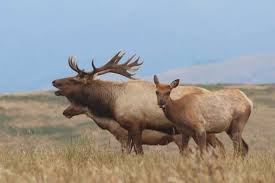In early August, the Point Reyes National Park Service released a draft management plan to address the future of its most controversial aspect: commercial cattle ranching. The draft includes potential plans to eradicate some of its native Tule elk: a locally beloved species which has existed on the California coast for over 10,000 years. Many conservationists are accusing the National Park Service of doing this to appease cattle ranchers, whose very presence on the seashore has generated intense controversy for years. Because elk and cattle compete for grazing, elk are seen as a nuisance to ranchers. The new draft management plan provides a list of potential management alternatives on the seashore. While the park’s preferred management plan would allow the shooting of a small number of elk each year, one potential management plan involves killing the entire Drakes Beach herd, consisting of 124 individuals.
“There is no valid ecological reason to ‘manage’ the elk at Point Reyes,” said Jeff Miller of the Center for Biological Diversity, “they are native, they are way under the park’s carrying capacity (and under the Park’s originally stated population goal for the free-roaming elk herds), and they evolved with and are beneficial to the park’s native ecosystems. The opposite is true for cattle – they are invasive, they are way overstocked, they cause significant damage to the park’s natural ecosystems.”
The Center for Biological Diversity is just one of many environmental organizations that have criticized the presence of commercial beef and dairy ranching on Point Reyes National Seashore. In the ‘60s and ‘70s the National Park Service purchased the ranches from their original owners, leasing the land back to ranchers to allow adequate time for them to move. Now, decades later, the commercial ranches are still operating on Point Reyes, and the ecological impact is very concerning to many environmental organizations.
Jim Coda is a local wildlife photographer, retired from a long career as an environmental attorney. Coda began driving out to Point Reyes from his Petaluma home in 2007 in search of bobcats and coyotes; and was delighted to discover the majestic Tule Elk, which became the subject of his photography for many years. “Point Reyes was my Yellowstone of California,” he says fondly. As Coda began to spend more time on the National Seashore, he started to notice things that “just didn’t look right”. Barren cattle trails eroded into hillsides, manure runoff into nearby waterways, and the destruction of native plants and introduction of invasive grasses were just a few of the many examples. What particularly upset Coda was the use of barbed wire around cattle pastures, which put elk at risk of entanglement. In one of Coda’s most upsetting photographs, a bull elk is seen with barbed wire dangling from his antlers. Coda has been fighting for years to put an end to commercial ranching on Point Reyes because of these negative impacts, and the National Park Service’s new plan to potentially kill native elk on behalf of introduced cattle is distressing to him. “It’s an egregious situation to be happening on a national park which is supposed to be protecting nature, not degrading it,” he says.
Laura Cunningham, California director of the Western Watersheds Project, has spent years assessing ecological damages caused by ranching on the National Seashore. “Point Reyes is one of the worst cases of land management I have ever seen,” she says. While Cunningham recognizes that most forms of agriculture do have some environmental impact, she believes that public lands and National Parks should simply be preserved as they are. “Public lands are for the benefit of all of us,” she states firmly, “not just for the commercial interest of a few livestock companies.” She fears that the killing of native species in favor of private interests will “set a bad precedent for all National Parks and monuments.”
Cunningham’s tone softens as she reminisces about the countless hours she used to spend at Point Reyes doing field sketches in the ’90s. “You’d get up at dawn and walk out there as the fog was breaking up over these grassy hills,” she recalls, “and you’d hear the elk bugle off in the distance, and it just….it made the hairs on the back of your neck stand up.” She describes the ungrazed portions of Point Reyes as being “a little piece of what California used to be.”
Cunningham hopes that more people will become involved in protecting the Tule Elk by submitting a comment on the draft management plan, which the National Park Service encourages members of the public to do. The draft management plan and comment forms are available until September 23 at parkplanning.nps.gov/poregmpa.



































